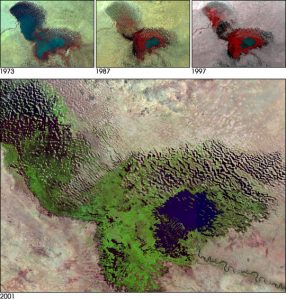Water may be the world’s most precious resource. But in many parts of the world it is a dwindling resource. One of the most dramatic examples of this is in Africa, where Lake Chad is now a twentieth of what it once was.
NASA has a bird’s-eye view – make that a satellite’s eye view – of the lake from 40 years ago, and a series of other photographs showing its not so gradual decline since then.

NASA Satellite Image
The once thriving body of water touches the shores of five countries – Chad, Nigeria, Cameroon, Central Africa Republic (CAR) and Niger. It has always been somewhat shallow and would rise and fall with the seasons, going from a few meters to about eight during the rainy season.
However, rainfall in the region has fallen since the 1960’s and an increase in agricultural production has siphoned off much of the water from the rivers that would normally fill the lake. Local populations also blame climate change for the lake’s decline, saying it’s hotter and drier than it used to be.
The countries closest to the lake formed the Lake Chad Basin Commission (LCBC) in 1964, and there are numerous organizations trying to help save the lake from completely disappearing. There are no easy answers, but a United Nations Environmental Program report says about 50 percent of the lake’s decline is from human water use, which includes major overgrazing in the region, as well as what it called “large and unsustainable irrigation projects.”
